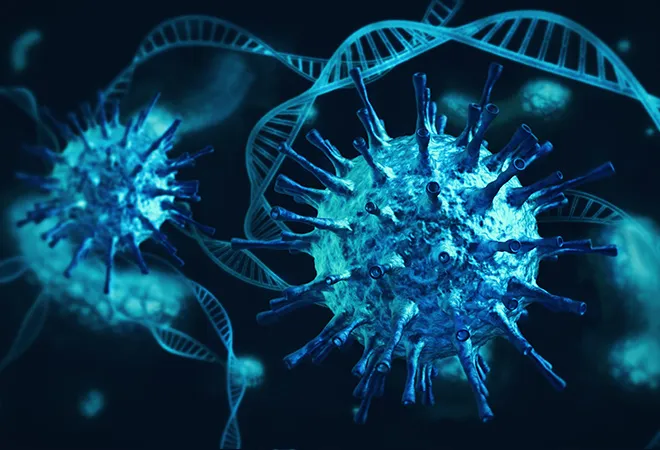
The pace of development of the COVID-19 vaccines and the scale of their roll-out is unprecedented in human history.
Adverse events, though rare, have been documented for COVID-19 vaccines and have impacted their uptake and resulted in vaccine hesitancy. Controversies around the vaccines further exacerbate the situation. One question that finds its way to many FAQs about the COVID-19 vaccines, particularly the relatively novel mRNA vaccines, is the concern that these mRNA or contaminating DNA from these vaccines can get inserted into and
alter the human genome.
Can a bit of foreign DNA (the gene that codes for the Spike protein of SARS-COV-2 for instance) present in the vaccine vial—as a contaminant of the process used to make the vaccine or in the case of the mRNA vaccines, the mRNA itself—integrate into the human genome and affect a person (make them prone to cancer perhaps or result in mutations)? From a molecular biology standpoint, this concern is puzzling, considering the number of low-probability events that need to occur for this to happen. Let us examine this in the two cases of the contaminating DNA and the mRNA present in the mRNA vaccine.
A recent preprint (a study that has not yet been peer-reviewed) reports higher-than-expected levels of DNA in expired mRNA vaccine vials, but the results are preliminary and the suitability of the methods used to make this claim is debatable.
The contaminating DNA Is presumably carried over from the process used to make the mRNA vaccines. For one thing, the mRNA vaccines have purification steps to remove this DNA (a circular plasmid from which the mRNA is synthesised). So, the amount of the contaminating DNA is likely to be low. A recent preprint (a study that has not yet been peer-reviewed) reports
higher-than-expected levels of DNA in expired mRNA vaccine vials, but the results are preliminary and the suitability of the methods used to make this claim is debatable. However, the key point is that the presence of the contaminating DNA is only the first in a long chain of events.
This DNA then has to get from the site of injection into cells, so the low amount of DNA is likely to get further diluted in the process. Thus, it is unlikely that there is enough of the contaminating DNA to get into many cells in large enough quantities.
Next, the DNA has to cross the cell membrane, enter the cell/cytosol, and then go from the cytosol of the cell into the nucleus—a separate compartment for the DNA and closely associated proteins—this is like entering a fortress. To do this, there has to be enough DNA, which has not degraded in any way (double-stranded, and ends protected in some way—for instance, circular DNA of plasmids). Not surprisingly, a lot of the DNA is likely to be lost in transit.
This, in fact, is a challenge that DNA vaccines need to overcome. This additional step (an extra membrane to cross cytosol-to-nucleus) is actually thought to be the reason that DNA vaccines produce a lower immune response as compared to mRNA vaccines.
Once in the nucleus, this piece of DNA must be intact and have the features necessary to subvert the machinery of a cell, which must be a dividing cell (a non dividing cell would be an endpoint), and integrate into the DNA, bypassing all the checkpoints in place to prevent DNA damage… the same mechanisms that prevent tumours every time a cell makes a copy of itself.
So, there are multiple molecular checks to ensure that such incorporation of DNA into the genome is rare. Having said that, some DNA viruses and viruses such as HIV are able to do it, so it is not entirely improbable. While integration can occur, it would be quite unlikely and one necessary step may be necessary for this piece of DNA to make copies of itself within the nucleus of a human cell, i.e., replication competence. Most of the COVID-19 vaccines are based on non-replicating vectors; this means that they do not have the sequences necessary to make copies of themselves even if they did get into a human cell.
While integration can occur, it would be quite unlikely and one necessary step may be necessary for this piece of DNA to make copies of itself within the nucleus of a human cell, i.e., replication competence.
So, say at some really low frequency this integration/mutation does occur; this is not enough. It has to occur in regions that actually code for functional proteins to be properly disruptive. There are huge stretches of the genome that don’t code for anything; maybe it is meant to act as a buffer against foreign DNA onslaughts like this one, over thousands of years of evolution. Even if a piece of foreign DNA did make it all the way to the genome of a cell, this modification will likely die with the cell—most cells in the body are differentiated cells and have a short life. To do real damage, such a DNA has to integrate within a gene of a stem cell, which lives in reasonably protected niches of the body.
So, overall, the likelihood of contaminating DNA present in the vaccine impacting the human genome is astronomically low.
What about the high amount of mRNA present in the vaccine?
In the case of the mRNA, while it is present in larger quantities than contaminating DNA, multiple modifications ensure that it stays in the cell cytoplasm and does not enter the nucleus. For mRNA to integrate into the DNA, this RNA must be converted to DNA by special enzymes called reverse transcriptases. This entire molecular pathway needs to be activated and become functional before the mRNA is degraded. In artificially cultured liver cells (that are quite different from cells within a person), researchers have shown that the mRNA from one of the
mRNA vaccines can be reverse transcribed into DNA. However, these results are restricted to this in vitro cell culture system which does not have the barriers and protections of a cell within the body. Additionally, in a healthy cell, the cellular defence against free-floating foreign RNA and DNA would likely kick in, thus making successful
reverse transcription of mRNA vaccines very rare. Also just like the process described for contaminating DNA above, the cell itself would likely die a natural death or come under the attack of the immune system (as it would be expressing the SARS-COV-2 spike coded by the mRNA vaccine) and be removed from the body without providing the opportunity for an integration event to happen or manifest itself. So again, it is very unlikely that the mRNA in the mRNA vaccine is going to change the DNA of a person.
Additionally, in a healthy cell, the cellular defence against free-floating foreign RNA and DNA would likely kick in, thus making successful reverse transcription of mRNA vaccines very rare.
This commentary has used the terms “unlikely” and “low probability” instead of “impossible” since organisms such as viruses have learnt how to break every rule in their host cell’s playbook to get ahead in the evolutionary race. This is why studies that look at different aspects of this process—starting from how much contaminating plasmid is present in the vaccine vial; is the load high enough to reach the cells; how many cells take up the DNA; does it get to the nucleus at all; does it persist there; does mRNA from the vaccine get converted to DNA within the body; when does it get cleared in different cell types, etc.—need to be done, rigorously and in multiple systems, especially as we gear up to use these vaccine technologies for more and more diseases. Presently, studies that raise alarms about the “integration” of COVID-19 vaccines and contaminating DNA, do not provide sufficient evidence across all these aspects to be taken seriously.
The views expressed above belong to the author(s). ORF research and analyses now available on Telegram! Click here to access our curated content — blogs, longforms and interviews.



 The pace of development of the COVID-19 vaccines and the scale of their roll-out is unprecedented in human history.
The pace of development of the COVID-19 vaccines and the scale of their roll-out is unprecedented in human history.  PREV
PREV


